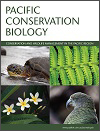Pacific Conservation Biology
Volume 31
Number 2 2025
Aviary bird-keeping for entertainment exacerbates the loss of bird biodiversity. We reveal the absurdity of bird keepers claiming to love nature and support conservation while engaging in practices that exploit and commodify birds for human interests. This also highlights the eco-deficit culture driving this absurd form of ‘nature love’.
Two Peoples Bay Nature Reserve in Western Australia has been managed for the conservation of threatened fauna for over 60 years. This review considers the range of species that have benefited, but also the complexity of managing a range of plants and animals concurrently. A long history of fire exclusion from core habitat for threatened fauna has seen significant conservation outcomes for some species, but other species and ecosystems may require more nuanced management.
This article belongs to the collection: The Natural History of Two Peoples Bay Nature Reserve, Western Australia.
The sustainable supply of fish for food is a policy priority for Pacific nations. Despite this imperative, the types and names of fish are not uniformly described and understood. The study provides the first comprehensive description of the 1031 species of fish consumed by Pacific people and highlights the need for comprehensive baselines of foodfish in a changing world.
Whitespotted whipray (Maculabatis gerrardi) and sharpnose whipray (Maculabatis macrura) are caught and traded in large volumes in south-east Asia. This study reveals late maturity (50% age-at-maturity of 5–6 years old), which makes them vulnerable to fisheries. A seafood trader who was interviewed perceives significant population declines.
The world’s largest lizard, the Komodo dragon Varanus komodoensis continues to survive in parts of Flores Island. Anthropological fieldwork reveals local knowledge of the dragons that complements information on their distribution derived from zoological field studies. Focusing on a region in north-central Flores Island, the paper analyses detailed, credible local accounts of these rare lizards that could contribute to conservation of the species.
Mapping the distribution of species from the genus Metrosideros is crucial for surveillance and management plans associated with species conservation. Such mapping requires accurate and accessible Metrosideros occurrence data and geographic information system data on island locations and extents. Here, we reviewed, compiled, and provided this data via an open science framework to support pan-Pacific conservation efforts.
Understanding the water chemistry of the Ayeyarwady River Basin in Myanmar is crucial for environmental and ecological studies such as fish migrations. This research reveals significant variations in trace elements along the river, highlighting the significant differences between freshwater and coastal environments. These findings shed light on future studies to track fish migrations in the basin.
According to modelled predictions, climate change will affect the distribution and existence of the genus Nothofagus in future. The objective of this study is to understand the impact of climate change on suitable distribution areas of Nothofagus in the Island of New Guinea. Recognising how future climate may influence the distribution patterns would be useful for employing a sound conservation strategy for the protection of these species in future.
Conservation of marine species is crucial for ensuring the health of marine ecosystems. Use of marine species, like sharks, must be properly regulated by management plans, including their trading. Shark trade should have accurate information concerning their correct identity using the most advanced and fast techiques, which will encourage to develop a sustainable trading.
Lizard traps are culturally and ecologically important Aboriginal-constructed rock formations found on granite outcrops. Directed by Merningar Elder Lynette Knapp, this paper provides the first robust evidence of reptiles using lizard traps as habitat. They teach that granite conservation requires minimising disturbance, deep knowledge of the landscape, and multi-generational thinking.
This article belongs to the collection: The Natural History of Two Peoples Bay Nature Reserve, Western Australia.
The iconic Southern Greater Glider (Petauroides volans) is threatened by increasing frequency and severity of wildfires under climate change. Since the Australian ‘Black Summer‘ fires of 2019–2020, it has recovered well under wet conditions in lightly burnt and moderately burnt sites but not in severely burnt sites. Reducing fire severity and protecting prime habitat are critical for its conservation.
Fire escape and survival is a key component of a species’ fire response and future recovery. The immediate fire escape potential of ground dwelling invertebrates is, however, poorly known, despite their importance to ecosystem services. We investigated this, and found that there is limited escape potential among this group except for a handful of taxonomic groups.
This study investigates fungal taxa consumed by five native marsupial species at two sites in southern Tasmania. Many of the fungi consumed and dispersed are mycorrhizal symbionts with the associated plant communities. This study highlights the conservation and ecological importance of these mammals in functional ecosystems in Tasmania and beyond.
Prey species carried to Crested Tern (Thalasseus bergii) breeding colonies on Penguin Island, Western Australia were photographed using digital telephoto cameras to monitor tern diet and fish availability for a declining population of Little Penguins (Eudyptula minor) sharing the same breeding island and foraging area.
Assigning a currency value to wildlife has been advocated as a conservation action for some threatened species and taxonomic groups for several decades. This paper describes the results of a 3-year program targeting eggs and nestlings of the endangered Carnaby’s cockatoo (Zanda latirostris). Although fledgling production was not adversely affected, commercial value was reduced by 38% after 3 years, and by 61% after 22 years. This program shows that an endangered cockatoo species can be successfully collected from the wild.
Gilbert’s potoroo (Potorous gilbertii) is the world’s rarest marsupial. It inhabits Two Peoples Bay Nature Reserve in Western Australia. Little was known about this species before it was presumed extinct at the beginning of the 20th century, so we share ecological and genetic knowledge learned over the past 30 years since its rediscovery.
This article belongs to the collection: The Natural History of Two Peoples Bay Nature Reserve, Western Australia.





